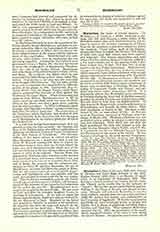

Maximilian, the name of several martyrs. (I) MAXIMILIAN OF ANTIOCH, a soldier, martyred at Antioch, January 353, with Bonosus, a fellow soldier, of the Herculean cohort; they were standard-bearers, and refused to remove the chrismon (monogram of Christ) from the standard, as had been ordered by Julian the Apostate. Count Julian, uncle of the emperor, commanded them to replace the chrismon with images of idols, and, upon their refusal, had them tortured and beheaded. The Roman martyrology and most other calendars mention them on August 21, while in a few martyrologies and in the heading which is prefixed to their Acts, September 21 (XII Ka.l. October) is designated as the day of their martyrdom. Both dates are wrong, as is evident from the Acts of the two martyrs, which represent Count Julian as infected with an ugly disease, contracted at the martyrdom of St. Theodoret October 23, 362. (2) MAXIMILIAN OF CELEIA.—His Acts, composed in the thirteenth century and unreliable, say he was b. at Celeia (Cilli, Styria), made a pilgrimage to Rome, went as missionary to Noricum, became Archbishop of Laureacum (Lorch, near Passau), and suffered martyrdom under Numerianus (283-4). It is historically certain that Maximilian was a missionary in Noricum during the latter half of the third century, founded the church of Lorch, and suffered martyrdom. His cult dates at least from the eighth century. In that century St. Rupert built a church in his honor at Bischofshofen, and brought his relics thither. They were transferred to Passau in 985. His feast is celebrated October 12, at some places October 29 (3) MAXIMILIAN OF THEBESTE, martyred at Thebeste near Carthage, March 12, 295. Thinking a Christian was not permitted to be a soldier, he refused to enter the army and was beheaded. Since death was not then the legal punishment for those who refused to join the army (Arrius Menander, Digest XLIX, xvi, 4 P. 10), it is probable that he was beheaded because he gave his Christianity as the reason of his refusal. He was buried at Carthage by the noble matron Pompejana.
MICHAEL OTT

